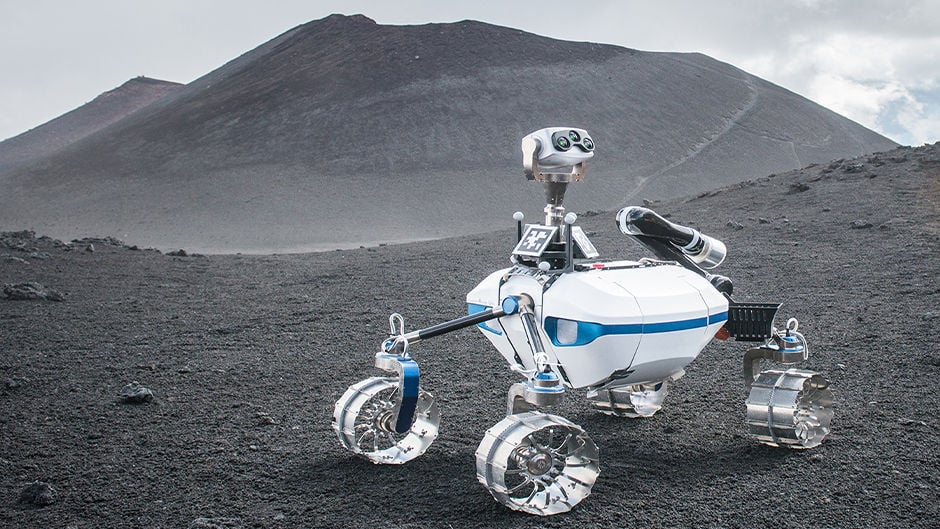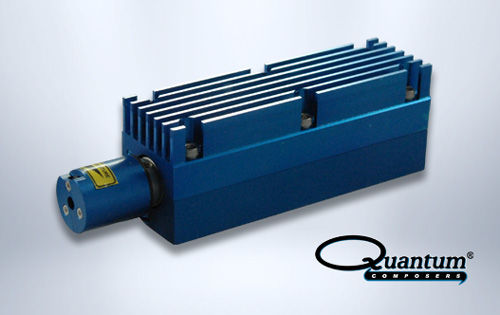Share this
Using LIBS in Autonomous Robots to Explore Geomaterial Composition in Space Exploration
November 2, 2022

Credit: DLR, German Aerospace Center. DLR’s LRU2 robot during the ARCHES space mission simulation on Mount Etna
LIBS, or Laser-Induced Breakdown Spectroscopy, has rapidly yielded valuable data in a recent demonstration of autonomous robots designed to explore foreign celestial bodies, such as the Moon. At the foot of Mount Etna, an active volcano in Italy, a space mission simulation was performed using several robots to navigate and map their surroundings and collect and analyze rock samples.
A modular LIBS instrument developed by Dr. Susanne Schroeder and colleagues from the DLR Institute of Optical Sensor Systems can be coupled to the robotic arm of one of DLR’s Lightweight Rover Units (LRUs) to determine the elements contained in a sample. The LIBS instrument, contained in a lightweight box, can be chosen by the robot from a set of tools and other modular instruments. It is then carried as a ‘backpack’ on the rover and placed onto a rock of interest in the target area. The chosen optics focus the laser at a fixed distance of about 7 cm from the instrument where some rock material is vaporized and turned into a small plasma. The plasma emission is subjected to spectral analysis, and the results are sent to the control center to determine the elemental composition.
MicroJewel DPSS Laser for LIBS
Dr. Schroeder and her team chose Quantum Composers’ MicroJewel for its compact size, low power consumption, and ease of integration with other commercially available components. Already in use in lab experiments for years, the MicroJewel performed reliably in field tests, despite environmental conditions.
The payload box that houses the LIBS instrument, including the MicroJewel Nd:YAG laser, spectrometer, and microcontroller, currently weighs about 1 kg and scans the LIBS’ targets at sampling rates of up to 30 Hz. The spectrometer covers wavelengths of 550-770 nm, allowing for the detection of rock-forming elements such as silicon, calcium, sodium, and potassium, as well as minor and trace elements such as hydrogen and lithium, and emission of nitrogen.
Current components should allow for further reduction of payload mass and volume for future missions. The MicroJewel today takes only a fraction of the available footprint on the LRU. Though the MicroJewel is designed for operating conditions of 15-30 degrees Celsius, using it in extraterrestrial environments would require active temperature control customizations to the instrument to maintain a suitable operating environment.
LIBS: Celebrating 10 Years in Space
LIBS has now been in use in space exploration for a decade with the ChemCam instrument on NASA’s Curiosity rover on Mars (Maurice et al., 2016). The successful operation of the LIBS instrument in the most recent ARCHES demonstration mission helped to achieve the mission goals and shows the importance of this technique to current and future space missions. On Earth, these autonomous robots, equipped with LIBS instrumentation, could also prove beneficial for tasks in places too dangerous for humans to work.
Preparing for exploration of the Moon and other celestial bodies will require a further reduction of payload, adaption to the specific spacecraft, shock testing, and temperature control. As Dr. Schroeder’s team prepares for future LIBS instrumentation on Moon-analogue and Mars-like scenarios, space-ready laser spectroscopy may provide important elemental analysis of rock or soil composition in planetary in-situ exploration.
Learn more about the MicroJewel.
Share this
- photonics (19)
- Lasers (12)
- DPSS Lasers (10)
- pulse delay generator (8)
- pulse generator (8)
- LIDAR (4)
- Lasers and Optics (4)
- Technology (4)
- Laboratory Science (3)
- Nd:YAG Lasers (3)
- PIV (3)
- Science (3)
- Spectroscopy (3)
- custom laser systems (3)
- Aerospace studies (2)
- Commercial Lasers (2)
- LIBS (2)
- Laser Induced Breakdown Spectroscopy (2)
- Laser Research (2)
- Laser Science (2)
- Particle Image Velocimetry (2)
- Pulsed Lasers (2)
- custom lasers (2)
- laser ablation (2)
- laser system (2)
- Biotech (1)
- COVID (1)
- Cancer (1)
- Cancer Diagnostics (1)
- Cancer Research (1)
- Current Generators (1)
- Dentistry (1)
- Emerald Pulse Generator (1)
- Flame Kernel (1)
- High Current Pulse Generator (1)
- Ignition and Combustion (1)
- Ignition flame kernel (1)
- Laser Dentistry (1)
- Laser Manufacturing (1)
- Laser Soldering (1)
- Laser Tooth (1)
- Laser aerospace (1)
- Laser photonics (1)
- MDA (1)
- Mass Spectroscopy (1)
- Micro Soldering (1)
- PIV Laser (1)
- Physics (1)
- Research (1)
- Surface mounted technology (1)
- ablation (1)
- artemis nasa (1)
- blue lasers (1)
- delay generator (1)
- er marketing (1)
- laser attenuator (1)
- laser modules (1)
- laser quality (1)
- laser sales and marketing (1)
- laser synchronizer (1)
- lasers for botanical safety (1)
- lasers for cannabis (1)
- lasers purity (1)
- lasers space (1)
- lunar mission 2021 (1)
- lunar missions (1)
- nasa lasers (1)
- nasa payload (1)
- oem lasers (1)
- photonics sales and marketing (1)
- system synchronizer (1)
- February 2024 (1)
- October 2023 (1)
- December 2022 (1)
- November 2022 (2)
- July 2022 (1)
- May 2022 (1)
- March 2022 (1)
- January 2022 (1)
- December 2021 (2)
- November 2021 (2)
- September 2021 (1)
- August 2021 (1)
- July 2021 (2)
- June 2021 (1)
- May 2021 (2)
- April 2021 (1)
- March 2021 (3)
- February 2021 (1)
- January 2021 (2)
- December 2020 (1)
- November 2020 (2)
- October 2020 (2)
- September 2020 (4)
- August 2020 (3)
- July 2020 (3)
- June 2020 (4)
- May 2020 (2)
- April 2020 (6)
- March 2020 (3)
- February 2020 (3)
- December 2019 (2)
- November 2019 (3)
- October 2019 (2)
- September 2019 (1)
- August 2019 (2)
- May 2019 (1)
- April 2019 (1)
- February 2019 (1)
- October 2018 (2)
- September 2018 (2)
- August 2018 (2)
- July 2018 (1)
- June 2018 (1)
- April 2018 (1)
- March 2018 (1)
- February 2018 (1)
- January 2018 (1)
- December 2017 (2)
- September 2017 (3)
- July 2017 (2)
- June 2017 (2)
- March 2017 (4)
- January 2017 (2)
- November 2016 (2)
- September 2016 (2)
- August 2016 (1)
- May 2016 (1)
- April 2016 (1)
- March 2016 (2)
- December 2015 (2)
- October 2015 (2)
- September 2015 (1)

